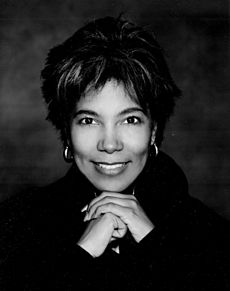Claudia Alexander facts for kids
Quick facts for kids
Claudia Alexander
|
|
|---|---|
 |
|
| Born | May 30, 1959 Vancouver, British Columbia, Canada
|
| Died | July 11, 2015 (aged 56) Arcadia, California, United States
|
| Alma mater | UC Berkeley, UCLA, University of Michigan |
| Scientific career | |
| Fields | Planetary science |
| Institutions | U.S. Geological Survey, Jet Propulsion Lab |
| Doctoral advisor | Tamas Gombosi |
Claudia Joan Alexander (born May 30, 1959 – died July 11, 2015) was an amazing American scientist. She was born in Canada. Claudia studied geophysics, which is about Earth's physical processes. She also studied planetary science, which is about planets and space.
Claudia worked for the United States Geological Survey and NASA's Jet Propulsion Laboratory. She was a leader for two big space missions. She managed NASA's Galileo mission to Jupiter. Later, she led NASA's part of the European-led Rosetta mission. This mission studied Comet Churyumov–Gerasimenko.
Contents
Early Life and Dreams
Claudia Alexander was born in Vancouver, Canada. Her mother raised her in Santa Clara, California. Claudia always loved to write and wanted to be a journalist.
But her parents wanted her to become an engineer. One summer, she got a job at the Ames Research Center. This job changed her mind. She found that she loved planetary science. It was fun and easier than she thought!
Education Journey
Claudia studied hard to become a planetary scientist. In 1983, she earned a Bachelor's degree from the University of California, Berkeley. Her major was geophysics.
Then, in 1985, she got her Master's degree from the University of California, Los Angeles. She studied geophysics and space physics. She looked at data from the Pioneer Venus Orbiter. This helped her learn about Venus's atmosphere and the solar wind.
In 1993, Claudia earned her Ph.D. from the University of Michigan. She specialized in the physics of space plasma. This is the study of charged particles in space.
Exciting Space Career
Claudia Alexander started her career at the United States Geological Survey. She studied plate tectonics, which is how Earth's big plates move. She also observed Jupiter's moons at the Ames Research Center.
In 1986, she joined NASA's Jet Propulsion Laboratory. She worked on the Galileo spacecraft. This mission explored Jupiter and its moons. Claudia became the project manager for Galileo's final phase.
The Galileo mission made amazing discoveries. It found 21 new moons around Jupiter. It also found an atmosphere on Ganymede, one of Jupiter's largest moons. This discovery made scientists rethink their ideas about Ganymede. Claudia oversaw Galileo's final dive into Jupiter's atmosphere in 2003. This ended the mission safely.
Claudia also researched many other space topics. She studied comets, Jupiter, and its moons. She also looked at magnetospheres, which are magnetic fields around planets. She even worked on the Cassini mission to Saturn. She wrote many scientific papers.
Inspiring Others
Claudia was a big supporter of women and minorities in science and engineering. She loved sharing science with everyone. In 2015, she gave a TEDx talk. She showed how to teach science to children in a fun way.
She also mentored young people, especially young girls of color. She encouraged them to follow their passion for science.
From 2000 until her death, Claudia was a project scientist for NASA's part of the Rosetta mission. This was a European Space Agency mission. It studied and landed on comet 67P/Churyumov-Gerasimenko. Claudia was in charge of important instruments for the mission. She also oversaw tracking the spacecraft from NASA's Deep Space Network.
Beyond Science
Besides her science work, Claudia loved writing. She wrote children's books, like "Which of the Mountains Is Greatest of All?". She also wrote science fiction. She even wrote for a tennis blog!
Claudia also enjoyed traveling and horseback riding. She had many interests outside of her scientific work.
Awards and Recognition
Claudia received many awards for her work. In 1993, she was named "U-M Woman of the Year in Human Relations" by the University of Michigan. In 2002, she won the Atmospheric, Oceanic and Space Sciences Alumni Merit Award.
In 2003, she received the Emerald Honor for Women of Color in Research & Engineering. This award recognized her achievements in science and technology.
A special scholarship was created in her name in 2007. The Claudia Alexander Scholarship helps students studying Climate and Space Sciences and Engineering at the University of Michigan.
Claudia was also a member of important science groups. She was part of the American Geophysical Union. She was also named "Woman of the Year" by the Association for Women Geoscientists.
In 2015, scientists on the Rosetta mission honored Claudia. They named a feature on comet 67P/Churyumov-Gerasimenko after her. It is called C. Alexander Gate.
Later Life
Claudia Alexander passed away on July 11, 2015, in Arcadia, California. She had battled breast cancer for 10 years. She is buried in San Jose, California.
See also
 In Spanish: Claudia Alexander para niños
In Spanish: Claudia Alexander para niños

